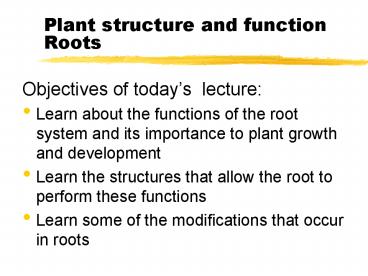Plant structure and function Roots - PowerPoint PPT Presentation
1 / 29
Title:
Plant structure and function Roots
Description:
clump of about 80 shoots, total leaf area of 51 sq. ft. 143 primary roots ... Root hairs contribute the largest fraction of root surface area ... – PowerPoint PPT presentation
Number of Views:902
Avg rating:3.0/5.0
Title: Plant structure and function Roots
1
Plant structure and function Roots
- Objectives of todays lecture
- Learn about the functions of the root system and
its importance to plant growth and development - Learn the structures that allow the root to
perform these functions - Learn some of the modifications that occur in
roots
2
Functions of the Root
- anchorage to the soil (or other substrate)
- absorption of water
- acquisition of mineral nutrients
- a tissue for energy (food) storage
- for propagation and dispersal of some species
3
Functions of the Root
- Root morphology is highly variable
4
Functions of the Root
- Root morphology is highly variable
- most dicotyledonous plants (those with 2 seed
leaves) have a prominent primary root - monocots (with one cotyledon or seed leaf)
typically have a more diffuse fibrous root system
5
How extensive are root systems?
- A 40 ft. tall oak tree
- primary tap root penetrated 14 ft. into the soil
- lateral roots extended to a radius of 60 ft.
6
How extensive are root systems?
- A single winter rye plant growing in a pot with 2
cu. ft. of soil - clump of about 80 shoots, total leaf area of 51
sq. ft. - 143 primary roots
- 35,000 secondary roots
- 2 million tertiary roots
- 11 million quaternary roots
- total root surface area of 6,500 sq. ft.
7
Importance of the root system in horticulture
- Essential for growth of virtually all plants
- Are there examples of plants that dont have
roots?
8
Importance of the root system in horticulture
- Many horticultural plants are transplanted
- in ornamental landscaping
- Trees and shrubs
- Perennials and annuals
9
Importance of the root system in horticulture
- Vegetable seedlings and fruit trees are
transplanted - Successful transplanting depends on a vigorous
and healthy root system - Many horticultural products are roots
- Primarily vegetables
10
Growth of the root system
- Root growth depends on the activity of the root
apical meristem - located just behind the root cap at the tip of
the root - provides a source of new cells for extension and
elongation of the root
11
Growth of the root system
- Growth of the root occurs at the tip
Ink dots are placed on the roots of a seedling
(A). As the seedling grows, the dots at the top
of the root (near the stem) stay in position. The
dots near the tip move apart (B), indicating that
this region is growing.
12
Tissues of the root
Root tissues can be regarded as a series of
concentric rings of different tissues
Epidermis
Cortex
Endodermis
Pericycle
Phloem
Vascular System
Cambium
Xylem
13
Epidermis
- Single layer of cells on the exterior of the root
- NOT covered with a cuticle
- root is designed for water uptake
- cuticle is a barrier to water
14
Epidermis
- Root hairs are specialized epidermal cells
- single cells that elongate perpendicular to the
root
15
Epidermis
- Root hairs contribute the largest fraction of
root surface area - In the winter rye example given earlier, more
than 4,000 sq. ft. of the 6,500 sq. ft. of root
surface area comes from root hairs - Epidermis functions in the uptake of water and
minerals - Large surface area facilitates uptake
16
Cortex
- Comprised of large undifferentiated cells
- Functions in the storage of food reserves
(proteins and starches) in root tissues
17
Endodermis
- Single layer of cells outside vascular system
- Spaces between the cells are covered with a waxy
layer, called suberin - Similar to grout between ceramic tiles, and
serves a similar function
18
Endodermis
- Blocks passage of water and dissolved nutrients
into the vascular system - Water, nutrients and other solutes must enter a
cell, cannot go round the endodermis
19
Endodermis
- Endodermis functions to regulate the uptake of
water and nutrients into the plant
20
Pericycle
- A thin layer of undifferentiated cells
- A meristem tissue
- The source of new lateral, or secondary, roots
21
Vascular tissue
- The transport system
22
Vascular tissue
- Phloem
- living cells comprised of seive tube elements and
companion cells - Cambium
- a meristematic tissue supplying cells that will
develop into vascular structures
23
Vascular tissue
- Xylem
- dead cells with thickened cell walls, typically
larger than phloem cells - functions in the transport of water and mineral
nutrients
24
A long look at the root
- A longitudinal section through the root (from
bottom to top) shows these various tissues and
how they develop.
25
A long look at the root
- Root cap
- Cells are sloughed off
- Protects the apical meristem
- Apical meristem
- Source of cells for the root
26
A long look at the root
- Elongation zone
- Where cells elongate and differentiate
- Pushes the root tip through the soil
- Maturation zone
- Cells develop their final form
- Root hairs form, xylem cells thicken and die
27
Organ
Tissue
Cell Type
Epidermis
Cortex
Parenchyma
Root
Casparian Strip
Endodermis
Parenchyma
Pericycle
Vascular System
28
Transpiration
- The continuum of water from soil, through the
plant and into the air
29
Root modifications
- The organ that is consumed in many vegetable
crops, such as carrot and sweet potato, is a
modified root that serves as a storage tissue - Other modifications for support































